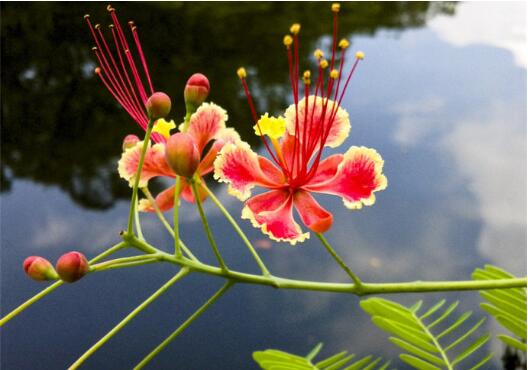What to do when buttercups grow worms? pest control of buttercups / 2 insect pests and 3 diseases
In the growth process of buttercup, the last thing we want to encounter is diseases and insect pests, this kind of problem is very harmful to the plant, not only affect the ornamental, but also lead to plant death. So what should we do if buttercups have worms? How to control the diseases and insect pests of Goldilocks? Next, the editor will take you to learn about it.
First, buttercup worms how to do, to find the reason

If you want to know what to do with buttercup worms, we must first understand what kind of insects grow, so that we can carry out targeted treatment, because the treatment methods of each kind of diseases and insect pests are different, and the details are introduced below. Friends who are troubled in this respect can take a look.
II. Pest control of buttercup (pest)
1. Shell worm
Scale insects prefer to grow in a warm and humid environment, which is easy to occur if the growth environment is too dry. It mainly threatens the branches, leaves and fruits of buttercup, which will cause the leaves to turn yellow gradually, the tree potential will gradually decline, and finally wither.
Control method: when we deal with the diseases and insect pests of this buttercup, we can spray it directly with 1000 times of imidophos or 2.5 times of deltamethrin.
two。 Aphids
Aphid is a plant-eating insect, which mainly absorbs the juice from the leaves of Jinfeng, which leads to the gradual green fading of the leaves, and in serious cases, it will lead to the continuous shrinkage and shedding of the leaves and affect its flowering.
Control method: for this kind of buttercup diseases and insect pests, we can directly use 50% marathon emulsion 1000 times or 50% aldicarb wettable powder 3000 times to spray it.
III. Pest control of Goldilocks (diseases)
1. Powdery mildew
Powdery mildew is a disease that may occur in many plants, and buttercup is no exception. During the disease, many white dust-like disease spots will appear on its leaves, and will gradually cover the whole leaf over time. As a result, the plant is unable to carry out photosynthesis and gradually die.
Control methods: when we deal with the diseases and insect pests of buttercup, we can use 1000 times of methyl topiramate wettable powder to spray the diseased plants, generally spraying once every half a month, about twice can be cured.
two。 Blight disease
This disease mainly affects the rhizome of buttercup, resulting in blackening or constriction of the rhizome, and white mildew in a humid environment. In general, the leaves of plants will wither within a few days when they are affected by this disease, and the whole plant will gradually die over time.
Control methods: in view of the diseases and insect pests of Goldilocks, we can use 1200 times of methyl iridofos EC to control the diseased plants, usually once every 7-10 days, 2-3 times can be cured.
3. Brown spot disease
Brown spot, also known as leaf spot, is a disease caused by fungi, which mainly threatens the leaves of plants. Many brown spots will appear on the leaves during the disease, and will spread gradually with the passage of time, resulting in plant death.
Prevention and control methods: when dealing with the diseases and insect pests of this buttercup, we can use 25% carbendazim wettable powder 300-600 times to prevent and cure it. Generally, the medicine is used once every 10 days or so, and it can be cured once or twice.
How to reproduce buttercups? the mode of reproduction of buttercups is / mainly by sowing.
Buttercup is the city flower of Shantou City, Guangdong Province, China. There are many people who breed it locally, but with more and more people raising buttercup, people are more concerned about its reproduction. About how buttercups breed? What are the breeding methods of buttercup? Next, the editor will take you to learn about it.
First, how to reproduce buttercups, mainly by sowing and breeding
When it comes to how buttercups reproduce, in fact, mainly by sowing and reproduction, this method has been tested countless times, and the survival rate is still very high. However, if you want to survive successfully, there are many things to pay attention to, such as the selection of substrate, the release of seeds and the methods of sowing. The specific operation methods are below, let's take a look.
Second, the reproduction mode of Goldilocks (sowing and propagation)
1. Sowing time, September-October
When we are preparing to sow and reproduce buttercup, it is very important to choose a right time period, which is usually the best time from September to October, because the temperature and humidity at this time are very satisfied with its growth conditions. After sowing, the nutritional needs are very easy to meet, and the natural survival rate is also very high.
two。 The selection of matrix and good drainage
Goldilocks prefer acidic soil, so we'd better choose loose and fertile slightly acidic humus soil as the matrix, this kind of soil has good drainage and air permeability, and can better absorb nutrients. And it is not easy to have stagnant water.
3. Matrix disinfection, high temperature disinfection
After we have selected the substrate, it is best to disinfect it first so as not to infect buttercups with bacteria. During disinfection, we can break it up and disinfect it in the sun. You can also put it in an iron pan and stir-fry it over high fire, so that even bacteria will be killed in high temperatures.
4. Seeds are precipitated and soaked in warm water.
After we have harvested the seeds of buttercup, it is best not to sow them immediately. We can soak the seeds in warm water for 1-2 days, and when the seeds begin to absorb water and swell, we will take them out and sow them. This can play a role in promoting the seed, so that it can germinate faster.
5. Sowing method, applying base fertilizer before planting
Before sowing, we should first apply an appropriate amount of base fertilizer to the substrate, and then sow the seeds on the soil surface, and the soil covered with 1cm can be watered. It is best to use the soaking basin method when watering. If directly irrigated, it is easy to wash away the seeds, and then the seeds can germinate in about three days.
What is buttercup language? buttercup picture.
✾
Goldilocks is a plant of the Impatiens family. It belongs to the genus Phoenix of Leguminosae. It has a nickname for the plant Phoenix. It is shrubby in shape and about 5 meters high. The Corolla is orange-red and golden on the edge, like a flying golden Phoenix. And the stamens are very long, much like the tail of the Phoenix. This kind of flower is in full bloom on the branches all the year round. It is a very valuable ornamental tree in the tropics and is suitable for growing in warm areas. It is cultivated in Yunnan, Guangxi, Guangdong, Taiwan and other places in China.
The stem of buttercup is fleshy, upright and stout. The height of the big tree of buttercup is generally 8-25 meters, the color is grayish white or light gray and there are many twigs. The crown of this plant is umbrella-shaped and the branches extend horizontally, slender, smooth and hairless on the branches, green or pink-green in color, and the flowers of buttercup are large, gorgeous and numerous. When it comes to flowering, the crown will be dyed scarlet, which is very beautiful.
Propagation and maintenance of ✾ buttercups 1. Buttercups are generally propagated with seeds. From mid-June to mid-December, the pods of buttercups will mature one after another, and September-October is its mature period. We will collect the mature pods and put them in the sun. When the seeds break off, they can be used for sowing. The seedlings of buttercups can survive the winter. You can also store the seeds until the following spring before sowing. Second, the seeds of buttercup germinate quickly. Generally, the seeds begin to germinate three days after sowing, and the germination will end within a week, and the germination rate is relatively high, about 60%. The seedling growth rate of seeds planted by strip sowing method is moderate. Nitrogen fertilizer is generally applied at the seedling stage and topdressing seedlings for 2-3 times, and nitrogen fertilizer and potassium fertilizer can be stopped after October to promote the early Lignification of buttercup plants. Buttercups need to be covered and frosted in winter.
✾ buttercup is a very beautiful flower. There is a legend about this plant. It is said that buttercup was chosen to be dedicated to St. Clade, Prince of Frank, but when his father died, St. Clyde was hunted by an uncle who wanted to seize the throne. In order to escape, St. Clade gave up the right to inherit the throne and became a priest, so the flower language of buttercup was on the run.
Conclusion: buttercup is a beautiful ornamental flower, the color of the flower is very bright, like a flying golden Phoenix, so it is of great ornamental value. We can breed it indoors as a potted plant, as an indoor decoration to increase beauty, or we can watch it elsewhere, but keep in mind the temperature conditions of buttercup. The above is the editor's brief introduction to buttercup language and breeding methods. I hope I can help my friends.
- Prev

What to do with the growth of peony orchid insects? pest control of peony orchid / 3 insects and 2 diseases
As a common indoor potted plant, the efficacy of peony orchid is very strong, it is not only good-looking, but also not vulnerable to diseases and insect pests, but also has good value in edible. But in indoor farming, for some reasons, peony orchid will inevitably be infected with disease and be disturbed by insects. that
- Next

What to do with the growth of malachite worms? pest control of malachite / 2 insect pests and 3 diseases
In the process of breeding peacock grass, the last thing we want to encounter is diseases and insect pests, this kind of problem is very harmful to the plant, which will not only affect the ornamental, but also lead to the phenomenon of death. What about the malachite worms? What should be done to control the diseases and insect pests of Peacock grass?
Related
- Fuxing push coffee new agricultural production and marketing class: lack of small-scale processing plants
- Jujube rice field leisure farm deep ploughing Yilan for five years to create a space for organic food and play
- Nongyu Farm-A trial of organic papaya for brave women with advanced technology
- Four points for attention in the prevention and control of diseases and insect pests of edible fungi
- How to add nutrient solution to Edible Fungi
- Is there any good way to control edible fungus mites?
- Open Inoculation Technology of Edible Fungi
- Is there any clever way to use fertilizer for edible fungus in winter?
- What agents are used to kill the pathogens of edible fungi in the mushroom shed?
- Rapid drying of Edible Fungi

